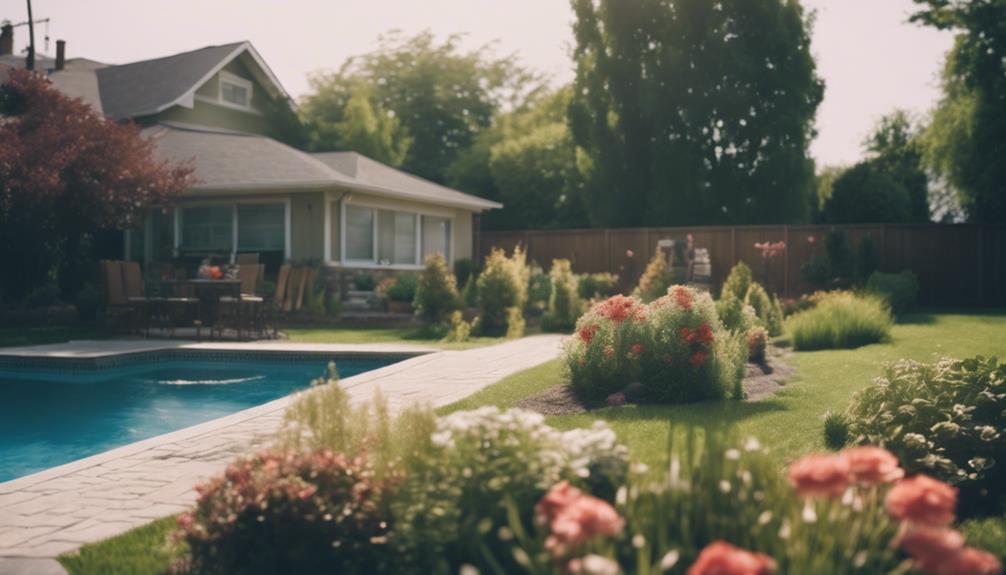When removing a swimming pool, it is important to adhere to local regulations, dismantle the pool into smaller pieces, and carefully remove any non-concrete parts. Hiring professionals ensures that the process is done in compliance with safety measures and expertly handles the excavation and drainage. It is crucial to plan for landscaping after the removal, considering proper drainage and soil evaluation. Using gravel as backfill material can improve drainage and stability, compacting it tightly around the pool. This summary offers essential tips for a successful pool burial. For a more comprehensive understanding of the process, further details are available for exploration.
Key Takeaways
- Check local regulations for pool burial compliance.
- Hire professionals for safe and legal pool burial.
- Use gravel backfill for stability and drainage.
- Plan landscaping post-removal for a clean finish.
- Compact soil after removal for structural integrity.
Legal and Regulatory Considerations
Before burying a swimming pool, it's important to thoroughly research the legal and regulatory considerations that may impact your project. Compliance with local regulations is essential when it comes to burying a pool. Different areas may have specific rules regarding pool burial, and failing to comply with these regulations can lead to fines or legal issues. Hence, it's essential to seek expert advice to navigate the legal considerations and guarantee proper compliance with all relevant laws.
Understanding the legal implications of burying a swimming pool is crucial to avoid any potential complications. In some locations, burying pools may be prohibited due to environmental regulations or local ordinances. Additionally, if you plan to build structures over the buried pool, there may be specific regulations that need to be followed to ensure safety and compliance.
Concrete Pool Removal Process

To efficiently remove a concrete pool, one must start by breaking down the pool floor into small pieces using a jackhammer for easier dismantling.
Progress by breaking the walls and deck into small fragments to guarantee a thorough dismantling process.
It's vital to remove all non-concrete materials like metal and plastic to facilitate a clean removal process.
Consider utilizing concrete cutting for thick or reinforced concrete sections to expedite the dismantling process.
Proper removal involves breaking the concrete into small pieces to aid in disposal and recycling efforts.
Additionally, compacting the soil after the concrete pool removal process is essential to ensure stability and prevent any potential issues in the future.
Importance of Hiring Professionals

Consider hiring professionals for burying a swimming pool to guarantee a safe and efficient process that complies with regulations and prioritizes safety. When undertaking a pool removal process, opting for professional pool burial services provides assurance of adherence to local regulations and codes, minimizing the risk of legal issues. Professionals possess the expertise needed to handle excavation, drainage, and structural considerations effectively, reducing safety concerns that could arise from improper handling.
Safety measures are paramount to professionals, who prioritize preventing accidents or damage throughout the burial process. Additionally, professional pool burying services can offer guidance on the appropriate depth, materials, and techniques required for an effective burial, ensuring the task is completed correctly. By engaging professionals, you not only reduce the likelihood of costly mistakes but also secure a successful and efficient pool burial process that meets all necessary standards.
Planning for Landscaping Post-Removal

Make sure proper drainage solutions are planned to prevent water accumulation in the former pool area when preparing for landscaping post-removal.
Evaluating the type of soil in the pool area is important in determining the best landscaping design that will thrive in this environment.
Consult with a landscaping professional to develop a detailed plan that complements your outdoor space and works well with the soil conditions.
Factor in the removal of any remaining pool structures or debris to guarantee a clean canvas for your landscaping project.
Best Backfill Materials

Gravel emerges as a top choice for backfill material due to its efficient drainage and compaction when burying a swimming pool. Unlike sand or dirt, gravel offers superior drainage capabilities, preventing water buildup that could safeguard the pool's structure.
Its ability to compact tightly around the pool ensures stability and reduces the risk of shifting over time. Superior Groundcover recommends using class 2 fill sand and pea stone for enhanced ground cover, emphasizing the importance of selecting the right material based on project goals and budget constraints.
When burying a pool, the backfill material plays a critical role in safeguarding the stability and long-term durability of the site. By choosing gravel as your backfill material, you're making a smart investment in the structural integrity of the buried pool area.
Frequently Asked Questions
What Do I Need to Know Before Building an Inground Pool?
Before constructing an inground pool, there are several key steps to consider:
- Ensure proper yard placement.
- Check local regulations for permits.
- Assess soil and drainage.
- Plan for extra costs like excavation and maintenance.
- Research pool material options (fiberglass, vinyl, concrete).
These steps are essential for a successful project that meets your needs and complies with regulations. By considering these factors, you can make informed decisions and avoid potential issues during the construction process.
How Do You Prepare the Ground for a Pool?
To prepare the ground for a pool, the first step is to excavate the area to the desired depth. Ensure proper drainage by creating a slope away from the pool. Compact the soil at the base for stability. Consider using gravel or sand as a base layer for better drainage.
Check local regulations to comply with zoning requirements. Following these steps will help create a solid foundation for your pool installation.
How to Bury an Inground Pool?
When burying an inground pool, you must first drain the water and dismantle the pool structure. Professional equipment and expertise are usually necessary for this process.
Local regulations and permits should be taken into account to guarantee compliance. Burying a pool can be a cost-effective option, especially for repurposing the area.
Proper backfilling and compaction techniques are essential to avoid future land issues. Make sure to follow these steps carefully for a successful pool burial.
Is It a Good Idea to Bury an Above Ground Pool?
Burying an above ground pool is generally not advisable due to safety risks and possible warranty voiding. Above ground pools lack the structural integrity needed for burial.
Consider semi-inground pools, designed for deeper burial with enhanced durability and lower costs compared to inground pools. However, be mindful of higher initial expenses, limited customization, and potential excavation costs.
Opt for reputable brands with nationwide shipping for inground pool benefits at a more affordable price.
Is it Necessary to Bury a Swimming Pool When Contracting Out a Build?
When contracting a swimming pool build, many homeowners wonder if it is necessary to bury the pool. While burying a pool can provide a sleek and low-profile look, it may not be necessary in all cases. Factors such as the landscape, drainage, and budget should all be considered before making a decision.
Can the Same Method for Disposing of an Above Ground Pool Be Used for Burying a Swimming Pool?
Yes, the same method for “disposing of swimming pool” can be used for burying a swimming pool. Proper draining, dismantling, and disposing of materials are essential. It’s also important to obtain necessary permits and comply with local regulations. Hiring professionals can ensure the job is done safely and effectively.
Can the Same Method for Disposing of an Above Ground Swimming Pool be Used for Burying a Swimming Pool?
Yes, the same method for disposing of an above ground swimming pool can be used for burying a swimming pool. However, it is important to follow local regulations and safety guidelines when disposing of swimming pool to ensure proper burial and environmental considerations are met.
Conclusion
To sum up, burying a swimming pool requires careful planning, adherence to legal regulations, and professional assistance.
By following the proper concrete removal process, selecting the right backfill materials, and planning for post-removal landscaping, you can guarantee a successful pool burial that's safe and environmentally friendly.
Remember to consult with experts in the field to ensure a smooth and efficient process from start to finish.










